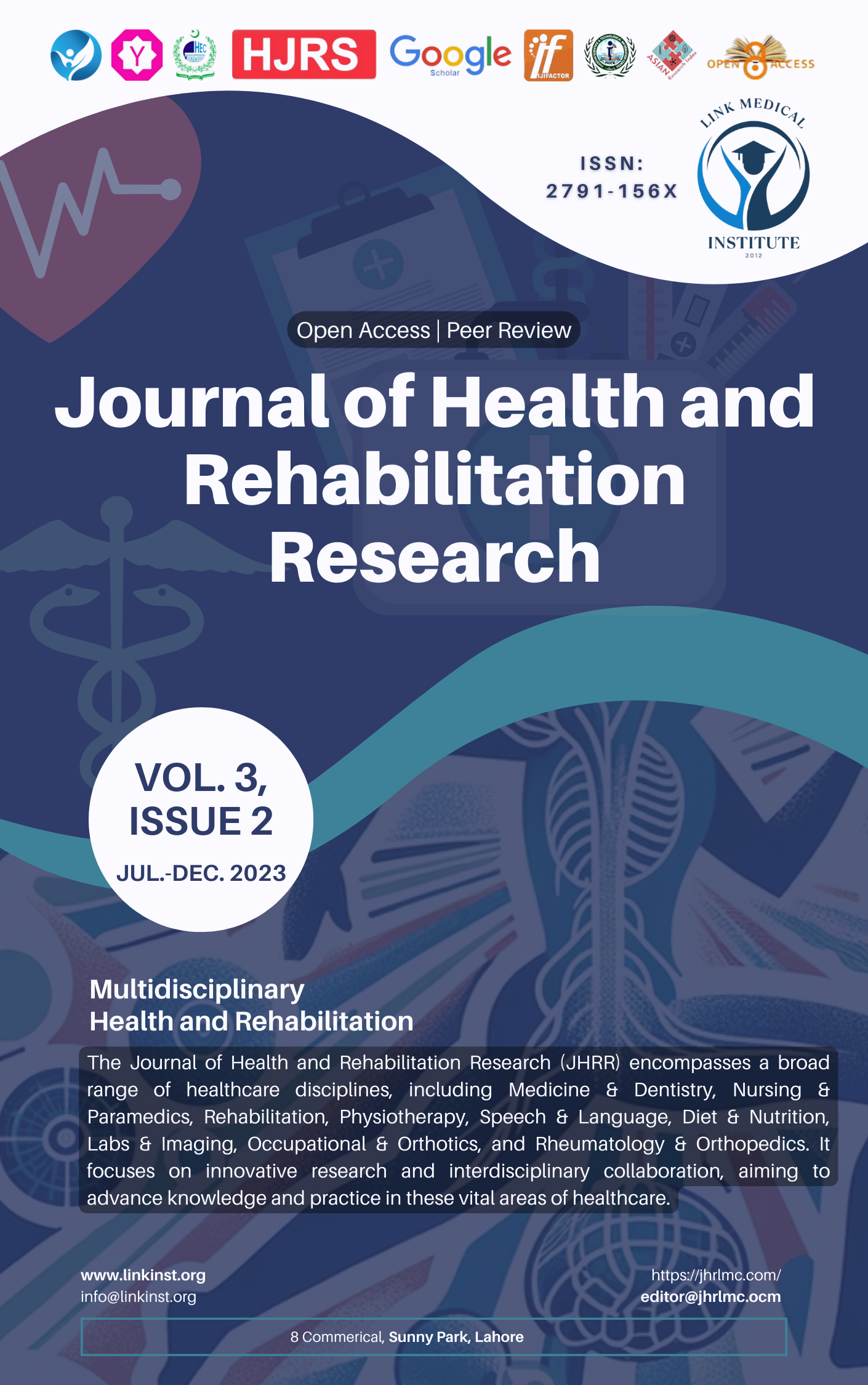Stone Free Success Rate by Using Modified Guy’s Scoring System in Patients Undergoing Percutaneous Nephrolithotomy
DOI:
https://doi.org/10.61919/jhrr.v3i2.236Keywords:
Renal Stone Disease, Percutaneous Nephrolithotomy, Stone-Free Rate, Modified Guy’s Stone Score, UrologyAbstract
Background: Renal stone disease (RSD) is a prevalent condition globally, with significant impacts on patient health and healthcare systems. The complexity of RSD management, particularly in achieving high stone-free rates (SFR) with minimal complications, necessitates ongoing research into effective treatment modalities. Percutaneous nephrolithotomy (PCNL) has emerged as a standard treatment, but predicting its success pre-operatively remains a challenge.
Objective: The study aimed to evaluate the efficacy of the Modified Guy’s Stone Score (M-GSS) in predicting the SFR in patients undergoing PCNL, and to analyze the relationship between various patient and stone characteristics and the success of the procedure.
Methods: This descriptive case series study involved 161 patients undergoing PCNL at a tertiary care center. Data on patient demographics, stone characteristics, and operative details were collected. Stones were classified using the M-GSS, and PCNL outcomes were assessed in terms of SFR. Statistical analysis was performed using SPSS 23.0, with a focus on the correlation between M-GSS grades and SFR.
Results: The overall SFR was 59.6%. The majority of patients (38.5%) were classified as M-GSS grade 1. The mean stone size was 2.74 ± 1.6 cm, and the mean operative time was 73.4 ± 14.6 minutes. There was no significant difference in SFR across different M-GSS grades (p=0.236). Stone size was the only factor significantly affecting the SFR (p=0.0001).
Conclusion: The study indicates that while M-GSS is a useful tool for preoperative assessment in PCNL, stone size remains a crucial determinant of SFR. The findings suggest the need for further research, particularly larger, multi-center randomized studies, to validate these results and refine preoperative patient counseling and outcome prediction strategies in PCNL.
Downloads
References
The prevalence of silent kidney stones--an ultrasonographic screening study. Buchholz NP, Abbas F, Afzal M, Khan R, Rizvi I, Talati J. J Pak Med Assoc. 2003;53:24–2
Khan N, Nazim SM, Farhan M, Salam B, Ather MH. Validation of S.T.O.N.E nephrolithometry and Guy's stone score for predicting surgical outcome after percutaneous nephrolithotomy. Urol Ann 2020;12:324-30
El Nahas AR, Eraky I, Shokeir AA, Shoma AM, El Assmy AM, El Tabey NA, et al. Factors affecting stone free rate and complications of percutaneous nephrolithotomy for treatment of staghorn stone. Urology 2012;79:1236 41.
Shahrour K, Tomaszewski J, Ortiz T, Scott E, Sternberg KM, Jackman SV, et al. Predictors of immediate postoperative outcome of single tract percutaneous nephrolithotomy. Urology 2012;80:19 25.
Thomas K, Smith NC, Hegarty N, Glass JM. The Guy's stone score--grading the complexity of percutaneous nephrolithotomy procedures. Urology 2011;78:277-81.
Ingimarsson JP, Dagrosa LM, Hyams ES, Pais Jr VM. External validation of a preoperative renal stone grading system: reproducibility and inter-rater concordance of the Guy's stone score using preoperative computed tomography and rigorous postoperative stone-free criteria. Urology 2014;83:45-9.
Mandal, S., Goel, A., Kathpalia, R., Sankhwar, S., Singh, V., et al. Prospective evaluation of complications using the modified Clavien grading system, and of success rates of percutaneous nephrolithotomy using Guy's Stone Score: A single-center experience. Indian Journal of Urology, 2012; 28:392. doi: 10.4103/0970-1591.10574
Kumar U, Tomar V, Yadav SS, Priyadarshi S, Vyas N, Agarwal N, et al. STONE score versus Guy's Stone Score-prospective comparative evaluation for success rate and complications in percutaneous nephrolithotomy. Urol Ann. 2018;10(1):76.
Singla A, Khattar N, Nayyar R, Mehra S, Goel H, Sood R. How practical is the application of percutaneous nephrolithotomy scoring systems? Prospective study comparing Guy’s Stone Score, STONE score and the Clinical Research Office of the Endourological Society (CROES) nomogram. Arab J Urol. 2017;15(1):7-16.
Lojanapiwat B, Rod-Ong P, Kitirattrakarn P, Chongruksut W. Guy’s Stone Score (GSS) Based on Intravenous Pyelogram (IVP) findings predicting upper pole access Percutaneous Nephrolithotomy (PCNL) outcomes. Adv Urol. 2016;2016.
Smith A, Averch TD, Shahrour K et al (2013) A nephrolithometric nomogram to predict treatment success of percutaneous nephrolithotomy. J Urol 190:149–156
Tefekli A, Ali-Karadag M, Tepeler K et al (2008) Classification of percutaneous nephrolithotomy complications using the modified Clavien grading system: looking for a standard. Eur Urol 53:184–190
de la Rosette J, Rioja-Zuazu J, Tsakiris P et al (2008) Prognostic factors and percutaneous nephrolithotomy morbidity: a multivariate analysis of a contemporary series using the Clavien classification. J Urol 180:2489–249
Vicentini FC, Serzedello FR, Thomas K, Marchini GS, Torricelli FCM, Srougi M, et al. What is the quickest scoring system to predict percutaneous nephrolithotomy outcomes? A comparative study among S.T.O.N.E score, guy’s stone score and croes nomogram. Int Braz J Urol 2017;43:1102 9.
Sinha RK, Mukherjee S, Jindal T, Sharma PK, Saha B, Mitra N, Kumar J, Mukhopadhyay C, Ghosh N, Kamal MR, Mandal SN, Karmakar D. Evaluation of stone-free rate using Guy's Stone Score and assessment of complications using modified Clavien grading system for percutaneous nephro-lithotomy. Urolithiasis. 2015 Aug;43(4):349-53. doi: 10.1007/s00240-015-0769-1.
Moreno-Palacios J, Avilés-Ibarra OJ, García-Peña E, Torres-Anguiano JR, Serrano-Brambilia EA, López-Sámano VA, et al. Rearrangement of the Guy’s Stone Score improves prediction of Stone Free Rate after Percutaneous Nephrolithotomy. Turk J Urol 2018; 44(1): 36-41
Singhania P, Raut N, Shringarpure S. Prediction of the stone-free rates after percutaneous nephrolithotomy (PCNL) using Guy’s stone score. PARIPEX-Indian JRes. 2016;5.
Hossain M, Ullah AT, Regmi S, Rahman H, Kibria SA. Safety and efficacy of the supracostal access for percutaneous nephrolithotomy: our initial experience. Bangladesh MedResCouncBull. 2011;37(1):34-8.
Khawaja AR, Dar TI, Sharma AK, Bashir F, Tyagi VK, Bazaz MS. Postpercutaneousnephrolithotomynephrostogram: is it mandatory? A single center experience. Adv Urol. 2014;2014.
Alobaidy A, Al-Naimi A, Assadiq K, Alkhafaji H, Al-Ansari A, Shokeir AA. Percutaneous nephrolithotomy: critical analysis of unfavorable results. Can J Urol. 2011;18(1):5542.
Pevzner M, Stisser BC, Luskin J, Yeamans JC, Cheng-Lucey M, Pahira JJ. Alternative management of complex renal stones. IntUrolNephrol. 2011;43(3):631-8.
Noureldin YA, Elkoushy MA, Andonian S. Which is better? Guy’s versus STONE nephrolithometry scoring systems in predicting stone-free status post-percutaneous nephrolithotomy. World J Urol. 2015;33(11):1821-5.
Okhunov Z, Helmy M, Perez-Lansac A, Menhadji A, Bucur P, Kolla SB, et al. Interobserver reliability and reproducibility of STONE nephrolithometry for renal calculi. JEndourol. 2013;27(10):1303-6.).
Downloads
Published
How to Cite
Issue
Section
License
Copyright (c) 2023 Saeed Ahmed Khan, Shahzad Ali, Naresh Kumar Valecha, Abdul Mujeeb, Khizer Ali, Afaque Hyder Shah

This work is licensed under a Creative Commons Attribution 4.0 International License.
Public Licensing Terms
This work is licensed under the Creative Commons Attribution 4.0 International License (CC BY 4.0). Under this license:
- You are free to share (copy and redistribute the material in any medium or format) and adapt (remix, transform, and build upon the material) for any purpose, including commercial use.
- Attribution must be given to the original author(s) and source in a manner that is reasonable and does not imply endorsement.
- No additional restrictions may be applied that conflict with the terms of this license.
For more details, visit: https://creativecommons.org/licenses/by/4.0/.






